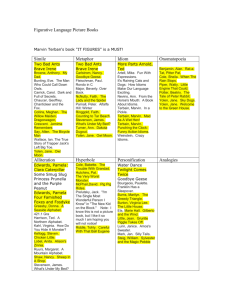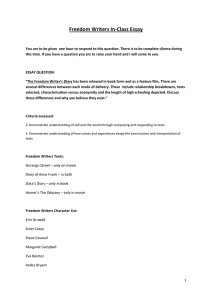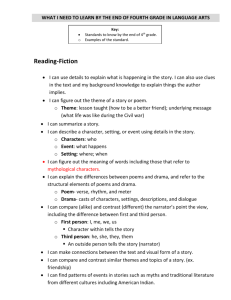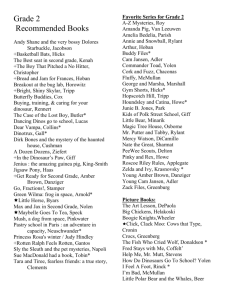A Few Choice Words - Southern Nevada Writing Project
advertisement
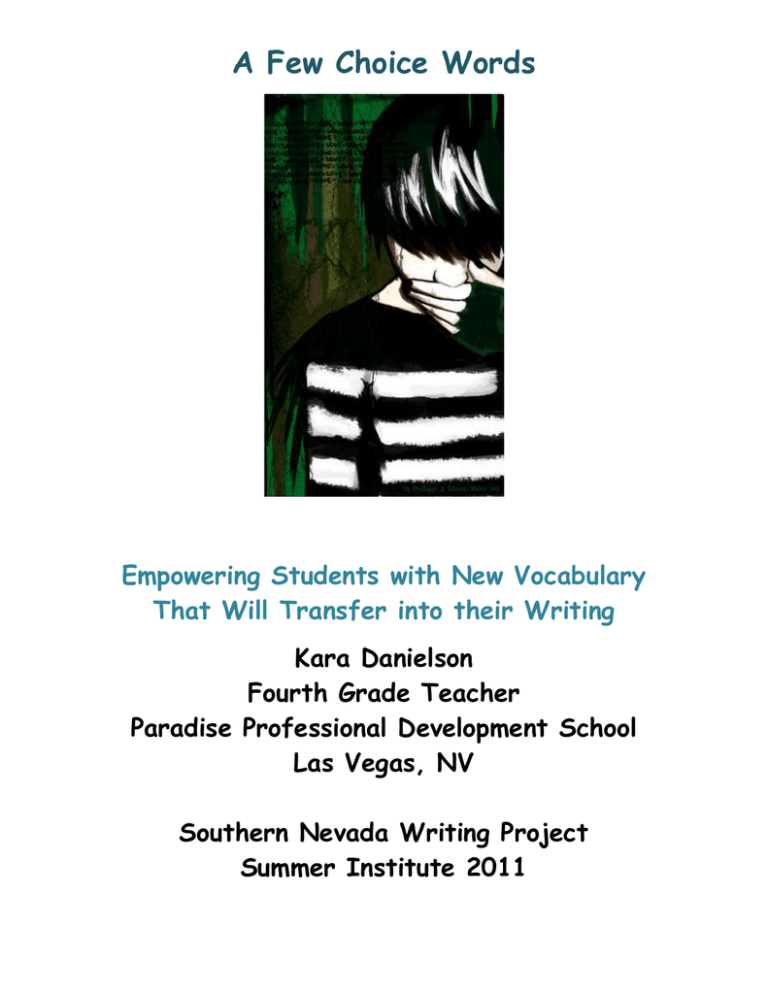
A Few Choice Words Empowering Students with New Vocabulary That Will Transfer into their Writing Kara Danielson Fourth Grade Teacher Paradise Professional Development School Las Vegas, NV Southern Nevada Writing Project Summer Institute 2011 Where I’m coming from… I’ve been teaching in Las Vegas for about four years and have taught a different grade level each school year. I’ve worked with struggling fourth and fifth grade readers and writers as a pull-out/push-in teacher, and I’ve taught all content areas in the classroom for first, third, and fourth grade students. Throughout my experience, no matter what grade level or in what socioeconomic area I have taught, I see children struggle with writing. Through my own love of writing, I have developed an even deeper love for teaching writing and helping students see the joy in the writing process itself! The dilemma develops… It was my fourth year of teaching, and this particular year I had a group of fourth graders that looped with me from third grade. I was excited about learning a new curriculum and I had always heard that fourth graders’ minds were ready to learn about the world around them. When the year began, our ELL (English Language Learner) strategist had offered to lead my class in a word study. Being a lifelong learner myself, I was ready to see what she could teach me about vocabulary development. I watched her introduce vocabulary and inspire students to get excited about the power of words. She modeled how to break words down using roots, prefixes, suffixes, and the meanings behind them, much like I have done in the past as well. This time, however, I had the opportunity to watch this group of fourth graders be fascinated with learning this new vocabulary and wanting to dive deeper into unknown, exciting, and amusing words. Their eyes lit up with excitement and couldn’t wait to go home and tell their parents how “cantankerous” their little brothers are and how “bamboozled” they were with a difficult math test that day. I thought she was on to something and couldn’t wait to take over and go even farther into my students’ passion for developing a rich vocabulary. Throughout the year, we used a variety of vocabulary development strategies I’d learned in previous years and experimented with new strategies I was curious about. We continuously utilized graphic organizers, context clues, comparing meanings within a variety of texts/content, dictionary and thesaurus practice, drawing, using visuals, acting out the meanings, and continuous use of the word throughout instruction and conversations. They loved learning and verbally utilizing their new found vocabulary so much I thought we should try and transfer it into their writing. We began a character trait unit where we studied characters in a variety of mentor books. During this unit, each student was also assigned three new character trait vocabulary words. Students were expected to become “experts” on these words through a guided self discovery. We completed a variety of previously learned vocabulary development activities so that students would understand each character trait’s meaning over a period of time. My assumption; they were now ready to transfer those vocabulary words into their writing. I modeled an example piece using our new found vocabulary and added student examples of an action or situation they had created to show that character trait through writing. The students were assigned two pieces of writing; one describing a “perfect” fourth grader and another describing a “naughty” fourth grader. Students were to use new character traits they had recently studied, and use creative exciting ways to show them through details. I was surprised with the outcome. They had used the same old mundane word choices they had always used. Sad, bad, mean, kind, nice, happy, etc. I wondered…. How can I further enrich students’ vocabulary and have it transfer into their writing as well? “The difference between the almost-right word and the right word is the difference between the lightning bug and the lightning.” Mark Twain Research tells us… “Children need early, more continuous robust vocabulary instruction to develop a vocabulary of sophisticated words.” Proximal Effects of Robust Vocabulary Instruction in Primary and Intermediate Grades Society for Research on Educational Effectiveness 14pp 2011 Apthorp, Helen; Mckeown, Margaret; Igel, Charles; Clemons, Trudy; Randel, Bruce; Clark, Tedra “…the amygdala, located in the Limbic System in our brain, controls our emotional memory.” The amygdala “determines whether information is emotional enough for long term storage and is relevant in all information transmissions.” “Active emotional engagement is a key to learning, because the amygdala’s response always matters!” Because of this, an instructor of mine, Saralyn Lasley, describes the amygdala as the “highjacker” of learning and stresses the importance of involving students’ emotionally through choice and interests. The Amygdala and Emotional Memory Larry Cahill, Ralf Babinsky, Hans J. Markowitsch & James L. McGaugh Center for the Neurobiology of Learning and Memory, University of California, Irvine, California “Students’ writing skills can be enhanced through improved vocabulary and by teachers creating a writer-centered classroom where instruction is individualized. “ Vocabulary’s Influence on Successful Writing: EPIC Topical Bibliography and Commentary 6pp 2003 Smith, Carl B., Ed. “The Vocabulary Self-Selection Strategy (Haggard, 1986)…..students are encouraged to choose words they have heard or seen in previous reading, but may not be able to define….this strategy is especially effective with students learning English as a second language. In the discussions students can explore word histories, synonyms, antonyms, and personal experiences.” West Virginia Department of Education Charleston, WV Portalupi and Fletcher note that when students come upon new vocabulary, they can be very intimidated. “You’ll want your students to feel comfortable using these new words in their writing. It may help to talk about ways other authors go about introducing special words to their readers.” Nonfiction Craft Lessons: Teaching Information Writing K-8 Stenhouse Publishers, Portland, Maine JoAnn Portalupi, Ralph Fletcher Reading Like a Writer… The research I found and discussions with fellow educators, led me to the book Wondrous Words: Writers and Writing in the Elementary Classroom by Katie Wood Ray. In Chapters 6, Organized Inquiry: Teaching Students to Read Like Writers, Wood Ray explains how to teach students to study texts and authors craft. To name what they see the author doing in regards to writing and imagine those strategies being used in their own writing. She uses the analogy of a seamstress “shopping” for ideas in clothing stores. While the rest of us are looking at sizes and price tags, the seamstress turns clothes inside out, studies patterns, stitches, and cuts. Students should read their texts like the seamstress. Looking and seeing all that they can. Nothing is too small or unimportant. Students should learn to turn the text inside out and analyze why the author makes certain choices. According to Katie Wood Ray, there are five parts to reading like a writer: Notice something about the craft of the text Talk about it and make a theory of why the writer does this Give the craft a name Make connections with other texts that use a similar craft Envision using this craft in your own writing “(chapter 5 and 6 will) describe kinds of inquiry that will help you and your students learn how to learn from writers…” “…explores how good writing starts long before drafts are even written…” “…will teach your students how to learn to write from writers.” ~Katie Hood Ray My Thoughts… Teaching students how to read like a writer will take some time, modeling, and practice. However, when students are comfortable with the process, I believe I can take this strategy, place a focus on vocabulary inquiry, and, hopefully, inspire students to transfer their new vocabulary to their writing as well. My attempt towards a solution… After creating a “reading like a writer” community in my classroom, I plan to implement the following activities and place focus on vocabulary inquiry. This process should take place over a period of time. I believe it is important to facilitate, guide, and model our own thoughts through each of these activities as well. I also believe the keys to these lessons are to provide as much choice as possible, guide students through their own discovery, and create an opportunity for students to take risks. 1. Provide students with a variety of text for their next “reading like writers” activity. Encourage students to choose a piece of literature that they are very interested in, whether it’s a graphic novel, play, fairy tale, nonfiction text, etc. It can even be a library book they have checked out that is not in your collection. Make it their choice. If more than one student has interests in the same piece of literature, allow the option of working with partners, or small groups. The choice of working with others, or individually, should be their choice at this point. 2. Students will begin the process by reading their literature like a reader. read for enjoyment get to know the text make connections discuss the text with a peer 3. Students will then begin to read like writers. Emphasize the fact that they should focus on vocabulary or phrases that they may have seen or heard before, but may not be able to define. study the text use post-it notes throughout reading the text; note unknown, interesting, and/or creative vocabulary and/or phrases make a list of “noticings” about the vocabulary the author uses - noted vocabulary - sentence/phrase attached to the word - why the author may have used this word students should choose two or three vocabulary words from the “noticings” list that they have the most desire to use in their own writing 4. Students should then discuss their chosen vocabulary words, why they chose them, and what they had noticed about how the author used them effectively. 5. Students will then begin the process of becoming “experts” on the meanings of their words of interest. provide students with a variety of resources to locate more information on their discovery to new vocabulary: - dictionaries - the internet - thesaurus -graphic organizers - texts with similar vocabulary facilitate and guide students through the process and allow student interaction and support 6. Students may present their new vocabulary to a peer, small group, or whole group; representing their words through pictures, example sentences, and/or acting demonstrations. 7. Students will then choose one, two, or all three of their new vocabulary words to inspire them to write a piece of their choice. give students the option to create any genre of writing - narrative - fantasy - informational - comic - play - poetry make the expectations clear - vocabulary usage - details to show meaning - creativity - student investment of writing - following the writing process - assessment of student writing inspire students to utilize their interests in the subject and/or chosen vocabulary consistently praise those who do use interesting and new vocabulary 8. Students should have the option to publish their piece, or not, depending on their emotional attachment to the writing. Personally, I just want to see the risk of using vocabulary, that may be less familiar to them, throughout their writing. Extensions: - Amazing Word bulletin board - Word Treasures: a collection of words students love - student generated thesauruses - student generated dictionaries According to The Revision Toolbox: Teaching Techniques that Work by Georgia Heard, creating an environment of “word awareness,” being encouraged to explore, play with, and rearrange words, deepens students’ understanding and curiosity of language. Standards within… RL.4.4. Determine the meaning of words and phrases as they are used in a text, including those that allude to significant characters found in mythology (e.g., Herculean). RL.4.1. Refer to details and examples in a text when explaining what the text says explicitly and when drawing inferences from the text. RL.4.7. Make connections between the text of a story or drama and a visual or oral presentation of the text, identifying where each version reflects specific descriptions and directions in the text. L.4.6. Acquire and use accurately grade-appropriate general academic and domain-specific words and phrases, including those that signal precise actions, emotions, or states of being (e.g., quizzed, whined, stammered) and that are basic to a particular topic (e.g., wildlife, conservation, and endangered when discussing animal preservation). L.4.4. Determine or clarify the meaning of unknown and multiplemeaning words and phrases based on grade 4 reading and content, choosing flexibly from a range of strategies SL.4.1. Engage effectively in a range of collaborative discussions (oneon-one, in groups, and teacher-led) with diverse partners on grade 4 topics and texts, building on others’ ideas and expressing their own clearly. W.4.3. Write narratives to develop real or imagined experiences or events using effective technique, descriptive details, and clear event sequences. or W.4.2. Write informative/explanatory texts to examine a topic and convey ideas and information clearly. Mentor Texts for Wondrous Words: A collection by Katie Wood Ray Striking Adjectives: “Then it was hugging time” from The Relatives Came (1985) by Cynthia Rylant Letting Swift River Go (1992) by Jane Yolen Miz Berlin Walks (1997) by Jane Yolen Out-of-place Adjectives: “….and drink lemonade cold” from My Mama Had a Dancing Heart (1995) by Libba Moore Gray Baby (1993) by Patricia MacLachlan Miz Berlin Walks (1997) by Jane Yolen Striking Verbs: “…blinded by dust and names paint-scrawled on their brick walls” from Secret Place (1996) by Eve Bunting My Great-Aunt Arizona (1992) by Gloria Houston The Whales (1996) by Cynthia Rylant Maniac Magee (1990) by Jerry Spinelli Miz Berlin Walks (1997) by Jane Yolen Striking Adverbs: “…a big moon balloon floats silent over trees” from The Lost and Found House (1997) by Michael Cadnum Miz Berlin Walks (1997) by Jane Yolen Nocturne (1997) by Jane Yolen Proper Nouns: “I saw Oreos and Ruffles and big bags of Snickers” from Missing May (1992) by Cynthia Rylant Baby (1993) by Patricia MacLachlan Make-Your-Own Words: “That’s why his front steps were the only unsat-on front steps in town” from Maniac Magee (1990) by Jerry Spinelli Nocturne (1997) by Jane Yolen Home Run (1998) by Robert Burleigh An Angel for Solomon Singer (1992) by Cynthia Rylant
